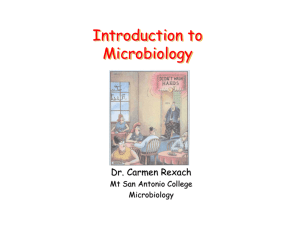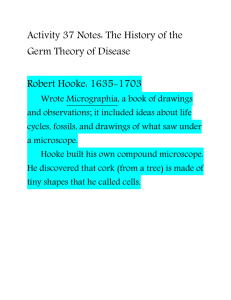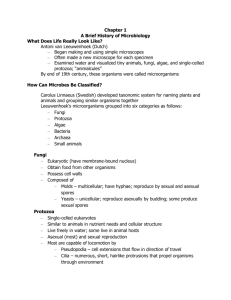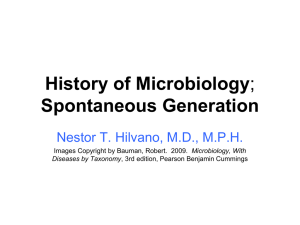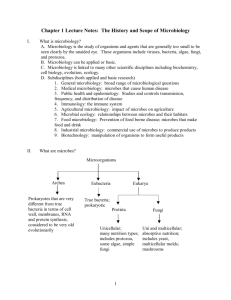Microbes_and_Society_files/Chapter one
advertisement
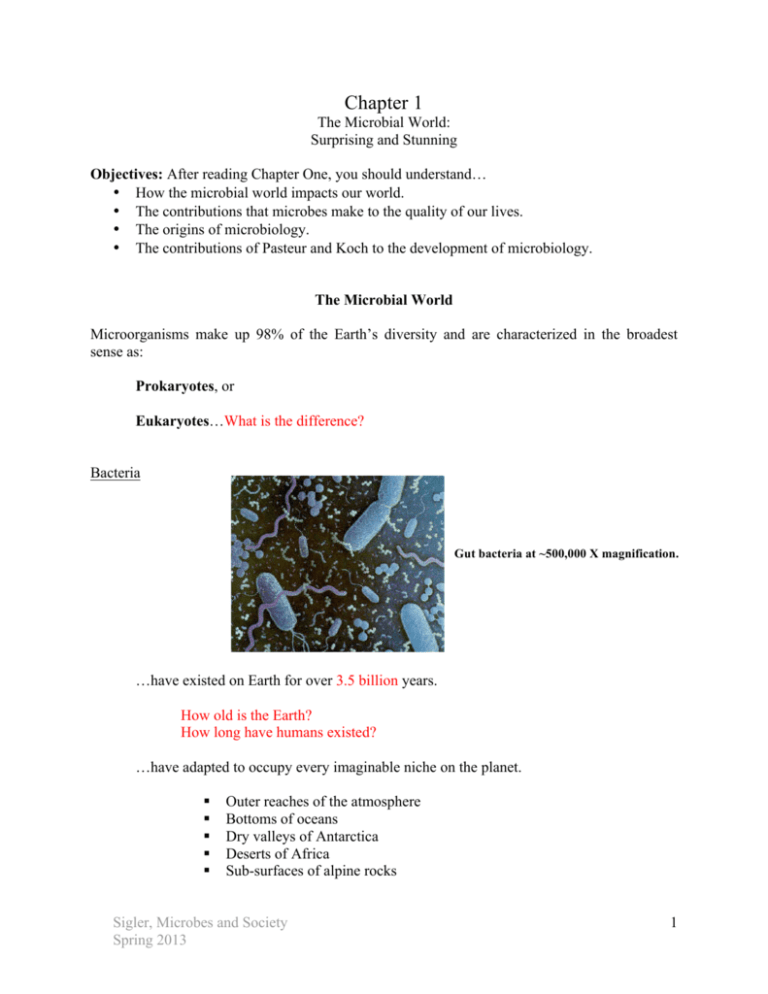
Chapter 1 The Microbial World: Surprising and Stunning Objectives: After reading Chapter One, you should understand… • How the microbial world impacts our world. • The contributions that microbes make to the quality of our lives. • The origins of microbiology. • The contributions of Pasteur and Koch to the development of microbiology. The Microbial World Microorganisms make up 98% of the Earth’s diversity and are characterized in the broadest sense as: Prokaryotes, or Eukaryotes…What is the difference? Bacteria Gut bacteria at ~500,000 X magnification. …have existed on Earth for over 3.5 billion years. How old is the Earth? How long have humans existed? …have adapted to occupy every imaginable niche on the planet. § § § § § Outer reaches of the atmosphere Bottoms of oceans Dry valleys of Antarctica Deserts of Africa Sub-surfaces of alpine rocks Sigler, Microbes and Society Spring 2013 1 In other words…VERY adapted…why? They are diverse…two examples: 1. They obtain energy in various ways Chemotrophs – energy from decomposition of organic or inorganic compounds. Phototrophs – energy from light compounds. What are humans? 2. They have various ways of metabolizing oxygen Animals require oxygen. Do bacteria? Most species utilize oxygen in metabolism (aerobic bacteria), but some need very little O2 (microaerophilic) or none at all (anaerobic). Anaerobic bacteria are important in oxygen-poor environments. Compacted landfills – important for anaerobic degradation of pollutants. From:www.groundwateruk.uk Sigler, Microbes and Society Spring 2013 2 Public health importance of bacteria: Disease-causing organisms are called pathogens. Why are bacteria so powerful in causing disease? 1. Fast reproduction (how fast?) 2. Exhibit effective defense mechanisms. 3. Opportunistic nature 4. Some can produce toxins Methicillin-resistant Staphylococcus aureus (MRSA) Viruses You can likely name a virus that has been in the news…but do you really know anything about these viruses? A virus is essentially nucleic acids surrounded by a protein coat…so is it alive? Viruses need a host in order to reproduce = obligate parasite. We think of viruses as pathogens, but…viruses can be beneficial: Viruses that cause common colds have been genetically modified to be less virulent, and then altered to carry genes that help to relieve the symptoms of cystic fibrosis (CF). What is CF? The altered virus carries the helpful genes to the respiratory tract cells. Why use a virus as a vector for dissemination of these genes? Sigler, Microbes and Society Spring 2013 3 Protozoa Differ substantially from bacteria and viruses. Protozoa contain nuclei, organelles, different energy metabolism mechanisms (so, are they prokaryotic or eukaryotic?). Protozoa at ~500X magnification A trypanosome ~6,250X magnification Photosynthetic protozoa are important as primary producers in the ocean food chain. Protozoa can also be detrimental: Cryptosporidium spp. caused more than 100 deaths in Milwaukee in 1993 when sewage entered the water supply. Sigler, Microbes and Society Spring 2013 4 Algae Plantlike, and contain photosynthetic pigments. Algae up close (Chlorella)… … and from afar (freshwater algal bloom) Several different types of photosynthetic algae inhabit oceans in high numbers. Form the basis of aquatic food chains (again, a primary producer). Using light as an energy source, photosynthesis creates carbohydrates (sugars) from CO2 and H2O (while producing O2), which becomes food for higher trophic levels. It is estimated that microscopic algae in oceans trap more energy, use more CO2 and liberate more O2 than all land plants and macroscopic algae combined. Algae as a human food source. Single cell protein – algae are cultivated in massive tanks, then dried and added to food such as ice cream and yogurt to enhance their nutrient content. Fungi The most important decomposers on Earth. Often filamentous – why is this structure important to the fungus? Sigler, Microbes and Society Spring 2013 5 Yeasts are fungi Important for brewing and baking. Beneficial fungi: Aspergillus niger – used in sake production, fading blue jeans, and spot removers. Claviceps purpurea– used to produce a drug to help with migraine headaches. Harmful fungi: Agricultural pests Ergot of rye (Claviceps spp.) Dollar spot of turfgrass (Sclerotinia homoecarpa) Water mold caused the Great Famine in Ireland in 1845. Sigler, Microbes and Society Spring 2013 6 The Roots of Microbiology Advances in the study of microorganisms are closely coupled with methodological advances. Most advances have been made in the past 40 years. Technology was much more primitive during the early years of microbiology. First magnifying lenses were constructed in 1267 by Roger Bacon. Useful to view detail on small macroorganisms, but not useful for microbiology In the early 1600s, Zacharius Janssen, a spectacle maker, found that two lenses were better than one – the first compound lens system. Magnified approximately 3-9X The “microscope”, as we know it today, was perfected in the 1620s by Galileo Galilei. In 1660s, Robert Hooke, an English philosopher and inventor, first used the microscope to look at cork, fungi that were infecting plants, and mold. Sigler, Microbes and Society Spring 2013 7 Hooke also developed the universal joint, respirator. Primarily a tinkerer, not a microbiologist. 1670s - Microbes first described by Anton van Leeuwenhoek. Van Leeuwenhoek’s early microscope ca. 1670. van Leeuwenhoek was a true scientist and chronicled his observations. § Microbes in wine and beer (important later) § Impact of pepper on microbes (environmental impact) § Asked Hooke to confirm findings (review) § Microbes in rainwater (habitat study) The diversity was fascinating to van Leuwenhoek, but what he saw were likely protozoa and not bacteria…why? These represented the first real microbiology studies Revolutionary for the 1600s Van Leeuwenhoek expanded the field of microbiology by communicating many of his results including the first formal discussion of bacteria in the late 1600s. Sigler, Microbes and Society Spring 2013 8 Louis Pasteur (1822-1895) In the 1800s the French were wondering why their wines were turning sour. Today we know that this occurs because the sugars in the wines ferment. What is fermentation? Prevailing theory: fermentation was purely a chemical process with no input by living organisms. Pasteur used experimentation to provide evidence against this… • Pasteur showed that tiny organisms were found in the wine. • Sour wines contained populations of the microorganisms described by van Leeuwenhoek. • When the organisms were killed through heating, no fermentation would take place. • When the organisms were added back, fermentation would again occur. While this was an important issue for French pride, a more important question was at the scientific forefront: Could microorganisms play a role in human health? Sigler, Microbes and Society Spring 2013 9 In the 1850s, Louis Pasteur thought that microbes might cause disease. This spurred massive re-interest in microbes. Technology advanced accordingly. Based on Pasteur’s observations of microbes in the environment, he reasoned that they could be transmitted to humans. This led him to propose the germ theory of disease, which stated that microorganisms play significant roles in the development of infectious disease. Led to the development of pasteurization, which ironically ended the sour wine problem. But…Pasteur’s critics held another point of view – spontaneous generation. Spontaneous generation (proposed by Pasteur's critics) From where do microbes that spoil food or cause disease originate? Two prominent theories: 1. “Seeds” or germs from the air (was not a widely accepted theory). 2. Arose spontaneously via a “life force”. Surprisingly, this theory was widely accepted! Pasteur provided evidence against spontaneous generation. First, he showed that by filtering air, he could trap organisms similar to those growing in rotten food. He also thought that if food was treated to render microbes inactive, then it should not spoil. So, Pasteur heated the food to kill microbes…no spoilage! However, critics were not satisfied with Pasteur’s experiment…so Pasteur performed more elaborate experiments to support his point. Sigler, Microbes and Society Spring 2013 10 So, he modified his experiments to include a “swan-necked” flask… Take Home Message – Pasteur is responsible for the ideas and theories that today drive efforts to promote food safety and prevent communicable diseases. Sigler, Microbes and Society Spring 2013 11 Nature of Infectious Disease (Robert Koch 1843-1910) In the 1500s it was known that disease involved transmission of some vector between people…but what was it? Even after the discovery of microorganisms, there was no proof that implicated them in causing disease. Koch worked with the bacterial disease anthrax (Bacillus anthracis), which, at the time, was associated with a blood infection in cattle and sheep. But was it the cause or the result of the disease? Koch used two steps of analysis of anthrax in mice to answer the question. First, Koch drew blood from a diseased mouse and injected it into a healthy mouse – the mouse became diseased. This was repeated several times to show that B. anthracis caused the disease. Additionally, microscopy showed that B. anthracis was always present in diseased blood. Sigler, Microbes and Society Spring 2013 12 Bacillus anthracis bacteria (purple rods) in cerebrospinal fluid sample. The other cells are white blood cells Second, Koch showed that B. anthracis cultured from the mouse retained its pathogenicity. These findings led to the development of Koch’s Postulates, which are the fundamental principles used to relate a single microbe to a single disease –this solidified Pasteur’s germ theory of disease. Sigler, Microbes and Society Spring 2013 13 Pasteur and Koch ushered in the Golden Age of Microbiology (1850s – early 1900s) Pasteur also described the principle for vaccine development. The transmission of several diseases was characterized: Mosquitoes – malaria Tsetse flies – sleeping sickness Rat fleas – bubonic plague Into the twentieth century Invention of electron microscope (when do you think that was?) Light microscope image of cocci bacteria (400X) SEM image of cocci bacteria on skin. (100,000X) The electron microscope facilitated the development of virology. Antibiotics were developed in the 1950s Age of Molecular Genetics Bacteria engineered to destroy pollutants Gene therapy Genetically modified plants Sigler, Microbes and Society Spring 2013 14


